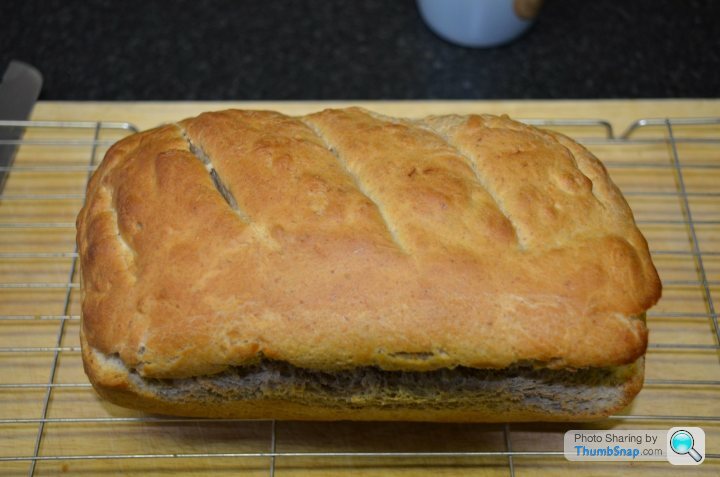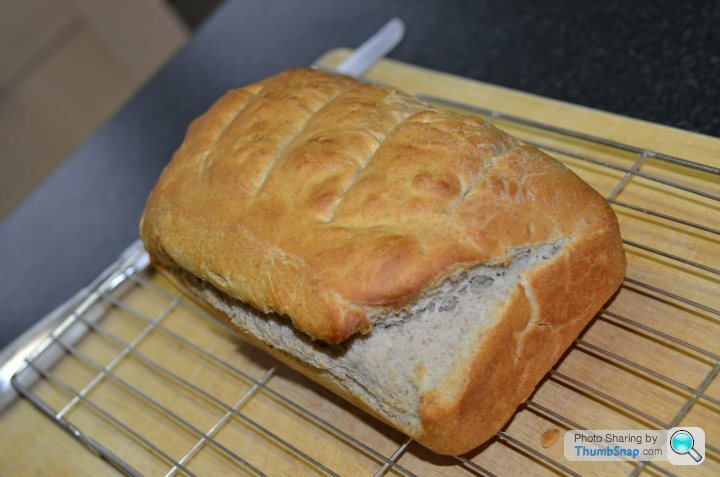Sourdough breadmaking
Discussion
jmorgan said:
Also suspect the gradients on my measuring jug are not right. Definitely one bigger than the other...
Weigh everything (except maybe the salt). 100ml of water = 100g, so no need to complicate matters by introducing inaccurate measuring jugs into the process!I took the opportunity to start a second starter on a recent visit to my parent's house, which is in a wine growing area with a lot more in the way of airborne yeasts (where I live there is, shall we say, a lot of fresh sea air so getting a sourdough starter going is very difficult). It took very quickly and the strain seems to be more active than the one I've been using for the past 5 years. Here's today's loaf made with it:
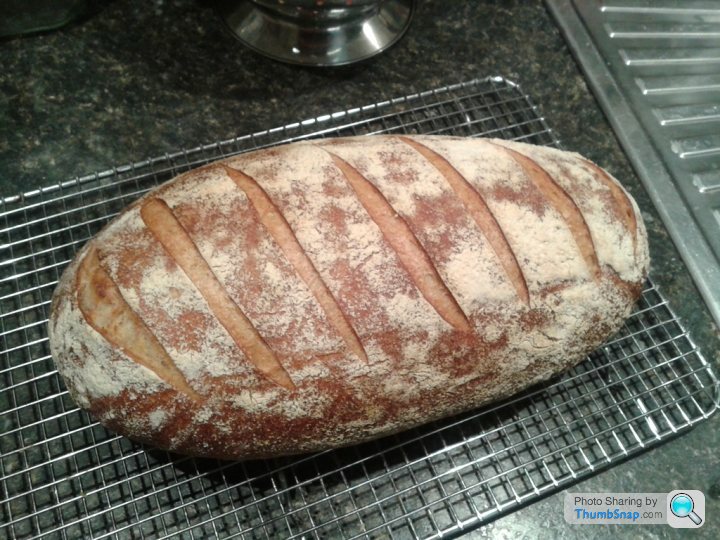
I'll try and remember to get an interior photo when I cut into it at breakfast in the morning...
When I have made single mixes, the 1 pint or litre seems to be OK. Problem here was making this size I measure 1/2 litre of starter and used the jug gradients to pour out half of that into each bowl. Not sure I have achieved what needs to be done here but warming the oven up now. Might have given it too long but we shall see.
One or two things. I think I need to make a single mix, more of the starter together to get a better raise? Both mixes have doubled in volume, just. But my old mixing bowl is too small. On my list to buy.
Not sure using the steel bowls a are good idea? Temperature issues maybe or not worth worrying about? The ordinary cob I did earlier this week came out fine but that was a few hours rise not many few hours.
Get my starter more active before using. It was on the go but I fancy I could have fed it a tad more before use.
Other than that the process is straight forward.
One or two things. I think I need to make a single mix, more of the starter together to get a better raise? Both mixes have doubled in volume, just. But my old mixing bowl is too small. On my list to buy.
Not sure using the steel bowls a are good idea? Temperature issues maybe or not worth worrying about? The ordinary cob I did earlier this week came out fine but that was a few hours rise not many few hours.
Get my starter more active before using. It was on the go but I fancy I could have fed it a tad more before use.
Other than that the process is straight forward.
You don't want to be measuring starter by volume! The actual amount in that 1/2 litre is going to vary significantly depending on the volume of air bubbles, which depends on how active the starter is. Seriously. Get some decent electronic scales and weigh everything. It's a lot easier to get consistent results that way.
Forgot to add: steel bowls are fine. I've been using them for years without issue.
Forgot to add: steel bowls are fine. I've been using them for years without issue.
Edited by uncinqsix on Sunday 31st March 10:34
jmorgan said:
I do have scales, followed the instructions page 2. Did I mis read something there?
No, I don't think you did. It's just that a recipe like that with vague measurements will be less predictable for a beginner as it relies on a degree of experience of what the dough should feel like at each stage. My approach would be to use much more carefully controlled proportions that allow for repeatable results. I would always recommend the Dan Lepard book MC linked to early in the thread as a starting point.
That book arrived the other day, some differences. I avoid working between two methods but the volume is the only thing that went by the jug. Flour was weighed to the gram. Salt from the tea spoon measure (5ml a go).
I also have another bread book and different recipe types call for quantities and switch between teaspoon and grams for example (that is one type will ask for salt in grams and another will ask for it in teaspoon), so if it calls for that that is what I have tended to use until I get a feel for it. So, the amount of water on page 2, I probably used a tad less as the consistency did not warrant it. I was looking for something similar to what I have been doing with ordinary bread.
I fear a disaster here anyway, but not worrying over it. Lessons have been learned.
Edit. It bombed out. Not rising enough, I know what to do for the next one. Baked two loaves anyway, not going to waste the leccy on the other two though might leave them covered to see what happens. They are rising but not very well.. Taste is OK, texture is a bit, shall we say, heavy.
Edit 2. Well, there is a thing. The two tins are still rising. Might be a goer in a few more inches.
I also have another bread book and different recipe types call for quantities and switch between teaspoon and grams for example (that is one type will ask for salt in grams and another will ask for it in teaspoon), so if it calls for that that is what I have tended to use until I get a feel for it. So, the amount of water on page 2, I probably used a tad less as the consistency did not warrant it. I was looking for something similar to what I have been doing with ordinary bread.
I fear a disaster here anyway, but not worrying over it. Lessons have been learned.
Edit. It bombed out. Not rising enough, I know what to do for the next one. Baked two loaves anyway, not going to waste the leccy on the other two though might leave them covered to see what happens. They are rising but not very well.. Taste is OK, texture is a bit, shall we say, heavy.
Edit 2. Well, there is a thing. The two tins are still rising. Might be a goer in a few more inches.
Edited by jmorgan on Sunday 31st March 16:32
Edited by jmorgan on Sunday 31st March 17:22
NormalWisdom said:
OK - So I cheated a little and got the bread-making machine to do the kneading
I think the mixture is a little wet but let's wait and see
In the bowl now ready for an overnight rise
Only did a 500g batch
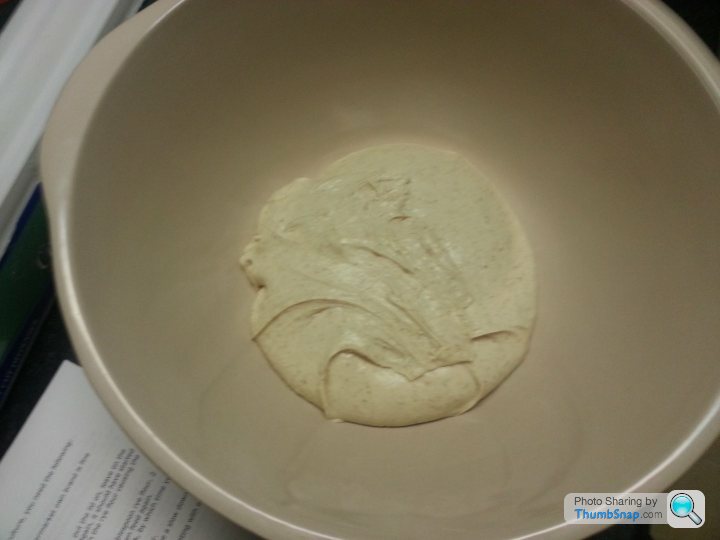
Yes looks a little bit wet Normal. What you do need to take into account is the amount of water within the starter. I think the mixture is a little wet but let's wait and see
In the bowl now ready for an overnight rise
Only did a 500g batch

As mentioned before, the liquid consistency of the starter itself is not critical, providing it is active.
I always start my dough by adding the starter, oil and salt first, and stir this all up before adding the water.
I then put in half my water, stir again, and gradually add more water as I knead in the bowl.
At the point when I stop adding water, the dough is usually feeling stiff but is still quite sticky.
Once you turn out onto the floured worktop and start kneading in earnest, as you work it, you will start to feel if it needs either a splash more water or a sprinkle more flour.
Regarding instructions to weigh everything precisely(including the water) However, the volume/weight of water needed will depend on the humidity in your kitchen, how dry your flour is, how wet your starter is, etc, so there really is no substitute for learning how the dough should feel.
NormalWisdom said:
As it was quite wet, I baked for 25 minutes at 175c, turned out of tin and baked for another 5 minutes. Worked very well!! And the taste is superb, and toasted is totally orgasmic!!
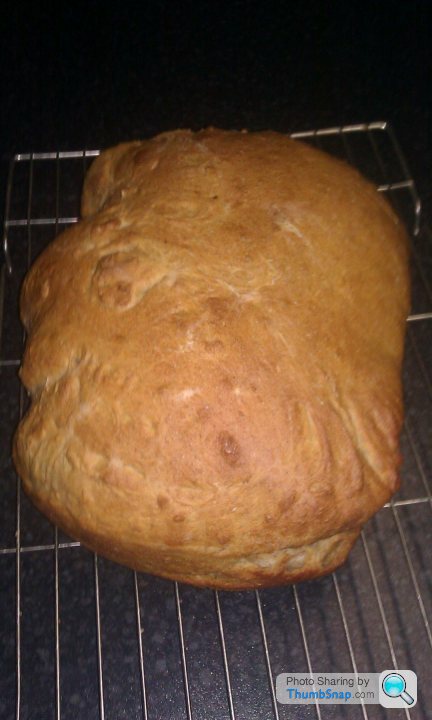
Yep wetter mixes still make good bread as youve discovered. Also if you add some extra oil as well before baking makes bloody good ciabbata type bread if its a bit wetter than normal.
Keep practising!
Edited by Boo152 on Monday 1st April 15:50
MagicalTrevor said:
I can't work out whether my starter is ok or not? If had a few bubbles on the top but nothing exciting. It looks like this 1 week in:
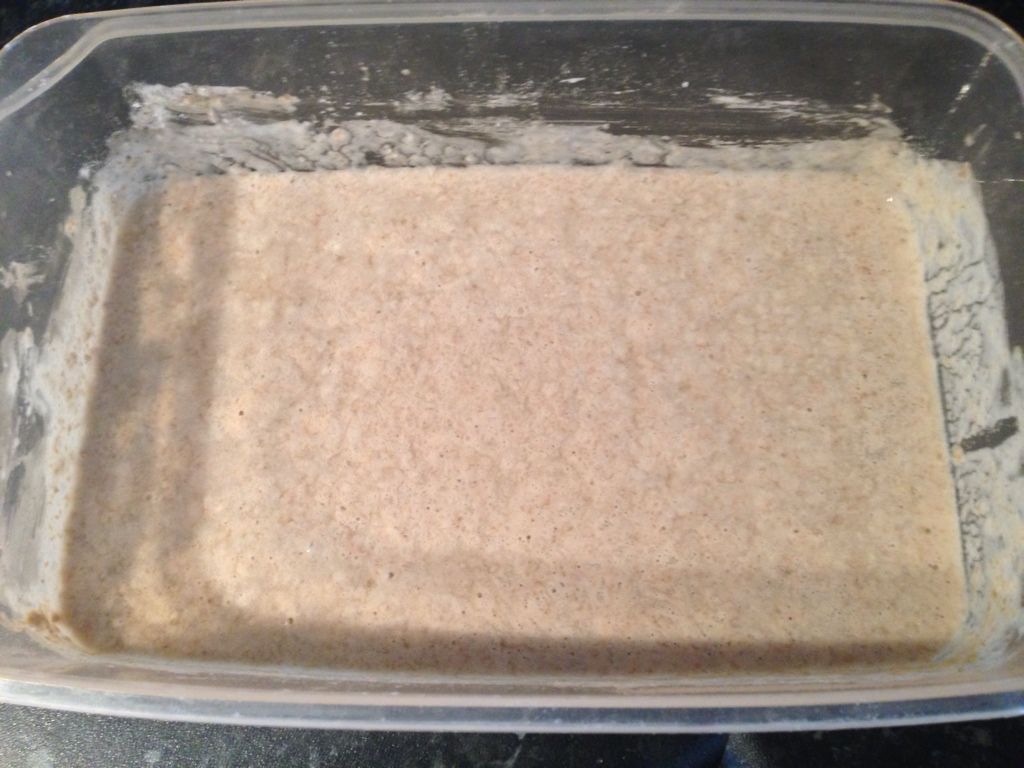
It's sat on a shelf in the kitchen in a plastic container with the lid loosely on the top I.e. not sealed
Is it ok?
That looks fine for a week old. Time to wack it in the fridge, keep feeding for another week by which time it should be ready to use. 
It's sat on a shelf in the kitchen in a plastic container with the lid loosely on the top I.e. not sealed
Is it ok?
After its finally feed before use (about half a day before you need it), leave it out on the worktop.
jmorgan said:
Think I got over confident. End result was too moist. Starter in the fridge for the time being. Might be a week today for the next go.
Keep at it Jeff. Practice will make perfect.PS: just got back from a long weekend away, took my starter and flour with me and fed daily!
Obsessive or what!?
Today's bake. As my speciallity this week thought I'd go for 'Un Baggette'.
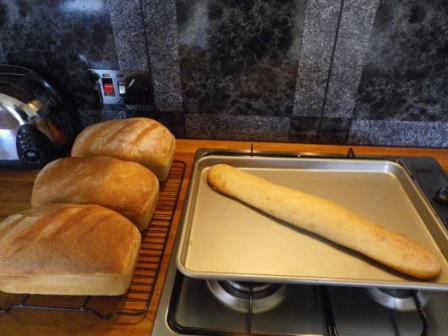
Le Baggette turned out a bit underbaked (as it went in after the loaves), but breakfast was on the table by then so had to eat it anyway!
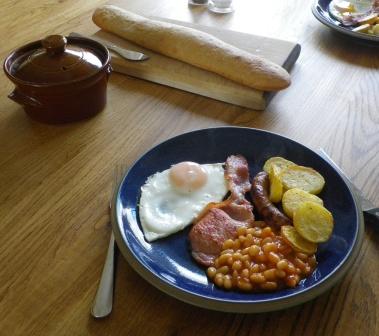
Chaps - Dont forget to set your recorders for Paul Hollywoods bread prog on Monday @ 8:30pm BBC2 - He's featuring Sourdough bread this time.

Le Baggette turned out a bit underbaked (as it went in after the loaves), but breakfast was on the table by then so had to eat it anyway!

Chaps - Dont forget to set your recorders for Paul Hollywoods bread prog on Monday @ 8:30pm BBC2 - He's featuring Sourdough bread this time.
Boo152 said:
Chaps - Dont forget to set your recorders for Paul Hollywoods bread prog on Monday @ 8:30pm BBC2 - He's featuring Sourdough bread this time.
His book's currently £7.99 on Amazon too. Quite tempted.Left my starter out of the fridge after feeding it last night, so I reckon a small feed to get it going when I get home and then have a go at batch 3 tonight and tomorrow morning. Last couple of attempts have been soggy in the middle, so after checking a few other books and recipies I think I need to try a higher heat than I have been doing.
My first couple of attempts were also too wet and didn't rise enough, this time round I sat it on top of the boiler for it's second rising, and then gave a 5-600g tin loaf 20 mins at 220, turned it out of the tin and then gave it another 15 mins at about 180. This one's cooked through properly but still not risen quite as much as I'd like.
Happens to mine occasionally, no effect on the taste so it doesnt worry me.
Possible causes: Drying out and 'skinning' during the second rise?
That would create surface tension as the heat from within the bread tries to escape theres nowhere for it to go so hence the split.
Dough too wet: So rather than rise straight up it flows sideways at first, then as it rises further, the side of the tin is holding it fast, so again something has to give.
Possible solutions: Make deeper slashes - that would then create a point of least resistance. Also make sure your tins are very well greased so the loaf isnt sticking.
I think also the trick is to get them in the oven whilst still on the rise (before the starter has 'exhausted itself')
Some bakers advocate covering with clingfilm or a tea towel during the prove. Others say putting water or ice cubes at the bottom of the oven to create steam makes a better loaf, but never tried either of that myself.
Possible causes: Drying out and 'skinning' during the second rise?
That would create surface tension as the heat from within the bread tries to escape theres nowhere for it to go so hence the split.
Dough too wet: So rather than rise straight up it flows sideways at first, then as it rises further, the side of the tin is holding it fast, so again something has to give.
Possible solutions: Make deeper slashes - that would then create a point of least resistance. Also make sure your tins are very well greased so the loaf isnt sticking.
I think also the trick is to get them in the oven whilst still on the rise (before the starter has 'exhausted itself')
Some bakers advocate covering with clingfilm or a tea towel during the prove. Others say putting water or ice cubes at the bottom of the oven to create steam makes a better loaf, but never tried either of that myself.
Gassing Station | Food, Drink & Restaurants | Top of Page | What's New | My Stuff





